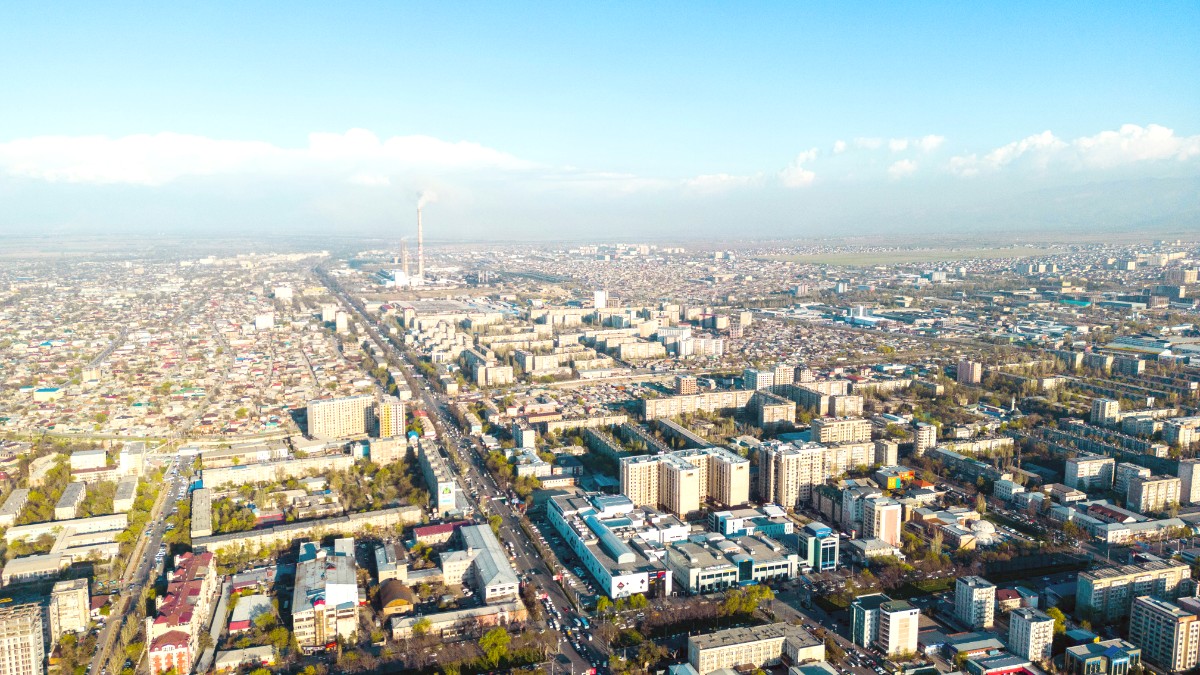
Kyrgyzstan
Spring (April-May) temperatures are 10°C to 25°C (50°F to 77°F). This period is mild, with increasing rainfall, notably in May. The city greens, and mountain wildflowers bloom. Humidity levels are moderate, for comfortable days. Expect cool evenings.
Summer (June-August) is hot and dry. Daytime temperatures generally are 25°C to 35°C (77°F to 95°F), sometimes exceeding 40°C (104°F) in July and August. Humidity is low, making the heat bearable. This is peak season for mountain activities.
In winter, Bishkek experiences significant air pollution (smog). This occurs from widespread coal use for heating and vehicle emissions, especially during temperature inversions. This affects visibility and air quality. Weather in the mountains around Bishkek quickly changes, even in summer. Bright sunshine quickly transforms into rain, hail, or snow at higher elevations. Always pack layers and be ready for varied conditions if heading into the mountains.
Autumn (September-October) brings mild and dry weather. Temperatures are 10°C to 25°C (50°F to 77°F). September is especially pleasant, with clear skies, comfortable temperatures, and less rain. The foliage in parks and mountain gorges turns , offering beautiful views. October brings cooler temperatures as winter approaches. Winter (November-March) is cold with frequent snowfall. Temperatures drop below freezing, from -10°C to 5°C (14°F to 41°F). January is the coldest month. Higher humidity occurs from snow, and the city feels quite chilly. Winter sports enthusiasts find this period ideal.
Peak for mountain activities, higher crowds.
Best weather for trekking and outdoor activities; all tourist facilities operate fully.
Higher prices for flights/accommodation; popular sites crowded; city can be very hot.
Pleasant temperatures, fewer tourists.
Comfortable temperatures; fewer tourists, often lower prices; beautiful blossoms/foliage.
Some high mountain passes may be closed; occasional rain in spring; shorter autumn days.
Ideal for winter sports, lowest prices.
Best for winter sports; generally lowest prices; authentic local experience.
Very cold temperatures, snow; limited mountain access; shorter daylight; significant air pollution (smog).
Mid-June to mid-September offers optimal conditions for high-altitude trekking and hiking, as most mountain passes are clear of snow and weather is generally stable.
December to March is prime for skiing and snowboarding.
Spring (April-May) and Autumn (Sep-Oct).
Mid-June to Mid-September.
Often in spring and autumn, check local calendars.
Summer is best for swimming and lakeside activities.
Kyrgyzstan maintains a liberal visa regime, making it relatively easy for many nationalities to visit. Always verify the latest regulations from an official source before your trip, as policies change.
Citizens of many countries enter Kyrgyzstan visa-free for up to 60 days (tourism, business, private visits). This list includes the US, Canada, most EU countries, Australia, New Zealand, Japan, South Korea. This simplifies travel. Simply arrive with a valid passport. Citizens not eligible for visa-free entry apply for an e-Visa online. This process is online via the official Kyrgyz e-Visa portal. Upload documents (passport scan, photo) and pay the fee online. The approved e-Visa is emailed for printing and presentation upon arrival. Processing takes 3-5 working days. Visa on arrival is generally not available for tourists.
Your passport must be valid for at least six months beyond your departure date from Kyrgyzstan. Immigration officials may request proof of your return ticket or onward travel plans. Have a copy of your first night's accommodation booking. If you obtained an e-Visa, print a copy of the approved document. Passport-sized photos are not typically needed for visa-free entry or e-Visa applications.
Budgeting for a trip to Bishkek offers flexibility. Kyrgyzstan is generally a budget-friendly destination compared to Western Europe or North America. The official currency is the Kyrgyzstani Som (KGS). Exchange rates fluctuate; check current rates. ATMs are widely available in Bishkek. USD and EUR are the easiest foreign currencies to exchange. Carry crisp, new bills for the best rates. Credit cards (Visa, MasterCard) are accepted in larger hotels, upscale restaurants, and major supermarkets in Bishkek. Cash is for smaller shops, local bazaars, marshrutka fares, and nearly all purchases outside the capital. Traveler's checks are not recommended.
While Kyrgyzstan is generally safe for tourists, being informed about health precautions and local safety measures is wise. This section provides actionable advice for preparation.
No specific vaccinations are for entry. However, ensure routine vaccinations are up-to-date (MMR, DTP, Varicella, Polio, flu shot). Consult a travel health professional 4-6 weeks before your trip for personalized recommendations. Common recommendations Hepatitis A & B, Typhoid (especially for those who eat outside major restaurants), Rabies (for extended outdoor time, animal work, remote areas), and Tick-borne Encephalitis (TBE) if visiting forested areas in spring/summer.
Medical facilities in Bishkek, notably private clinics, are generally better than in other parts of Kyrgyzstan. However, they may not meet Western standards for complex or serious conditions. For major medical emergencies, medical evacuation to a country with more advanced facilities (e.g., Turkey, Western Europe) is often recommended. Pharmacies ("apteka") are common in Bishkek.
Tap water in Bishkek is generally not safe for direct consumption. Use Bottled water. Consider a Filtered water bottle or Purification tablets.
Bishkek is generally safe. Petty crime, like pickpocketing, happens in crowded areas (Osh Bazaar, public transport). Be aware of surroundings. Avoid large gatherings and protests. Use official taxi apps like Yandex Go.
Kyrgyzstan is in an active seismic zone. Minor tremors are common; stronger earthquakes can occur. Landslides and mudslides happen in mountains after heavy rain. Avalanches are a winter/spring risk in high mountains.
Always prioritize common sense and awareness of your surroundings for a safe trip. Obtain comprehensive travel insurance for medical emergencies, including medical evacuation.
These resources are for additional safety measures and compensation related to travel.
Consider LifeStraw for personal water filtration.
Carry Adventure Medical Kits for essential first aid.
Secure valuables with Pacsafe products.